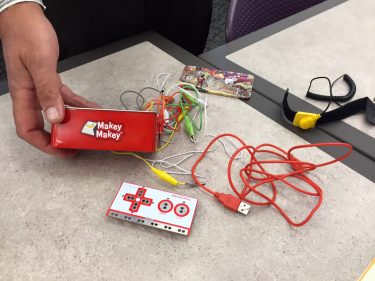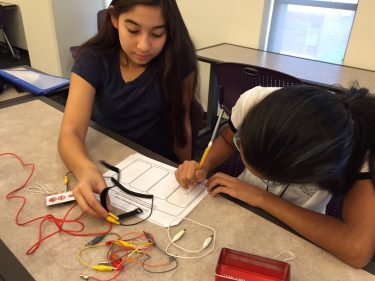
Story and photos by Laurie Merrill
GCU News Bureau
Class was over, but these boys and girls didn’t budge. They sat, hunched over their tables, their imaginations firing on all cylinders as they focused their attention on their team project: making a game controller for a girl with special needs.
“I wish we could stay here so we could finish it,” said Ben Slater, a seventh grader from Canyon Breeze School in Avondale.

Like the other 200 students from across Arizona who are visiting Grand Canyon University this week, Slater is a Chief Science Officer (CSO), a student elected by his peers to promote Science, Technology, Engineering and Math (STEM) education at his school.
The CSOs are attending a three-day Chief Science Officer Training Institute at GCU that features a packed schedule of activities, speakers and classes designed to strengthen their abilities as team members, leaders and school science ambassadors.
Megan Smith, U.S. Chief Technology Officer and Assistant to the President, is scheduled to be the keynote speaker Wednesday, and Bob Witwer, vice president of advanced technology for Honeywell Aerospace, spoke Tuesday.
Slater and about nine other students were in the “The Art of Making” session taught by Al Pajak with the Arizona Science Center and Mary Mueller, a State Farm Insurance community mentor.
Their assignment, Pajak said, was to build a remote control for an 8-year-old girl named Hayden who was born with defects and can’t use her left arm.
Using circuit boards, supplies, plenty of imagination and, perhaps most important, empathy, two teams of students set to work to design a game controller so that Hayden could have fun playing games with her family.

“You could have a single joy stick,” Slater said. “And you could make the controller for her lap.”
Dhruv Khosla, a Rancho Solano 10th grader, suggested they add an extension to compensate.
They were thinking broadly, bouncing ideas off one another to trigger thoughts they might not have had apart from the team, a concept Witwer had discussed earlier during the lunch speech.
“Dialog occurs when a group of people gets together and suspends certainty in their own beliefs and they reach a level of thought they had never had,” Witwer said, quoting another educator.
After the students reluctantly left behind their partially built game controllers, Khosla said the class was effective.
“I think it was a lot of fun,” he said. “It was a fun way to show the engineering design process and it was a fun way for us to interact.’’
Slater said he thought they could have built Hayden’s controller if they had another half-hour, but he nonetheless appreciated the class.
“You’re helping other people with designs that you built,” he said.
Contact Laurie Merrill at (602) 639-6511 or [email protected].















